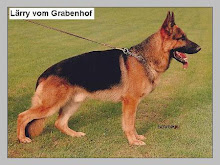A simple and adorable trick that you can easily teach your dog or puppy is to have her cross her paws. Many pets will do this by accident and it always puts a smile on my face when I witness this cute sitting posture.
You can easily teach train your dog to lie down and look elegant with its paws crossed by following these simple instructions:
Step 1: Start the exercise with your dog in the down position (of course he should already be trained to do so before attempting the 'cross paws' trick)
Step 2: Now have your dog offer his paw on command. If he does not know how to respond to this command yet, simply reach out and grab one of his paws. Be sure to click once (using a clicker) and offer a small treat each time. It is important that your dog remains in the down position while doing this.
TIP: If he still struggles to understand how to give you his paw, simply use the treat and place it in the palm of your hand a few inches is a way from one of his paws. Soon enough, he will naturally move to touch the treat that is in your hand in hopes that you will release the tasty snack. Be sure to click each time he taps your palm.
Step 3: Continue having your dog offer his paw, but be sure to concentrate only on one paw at a time and do so repetitively with a click and a treat.
Step 4: When your dog has reached the stage where you can rely on him to target your hand with one of his paws, slowly move your hand closer to your dog's other front paw. Now in order to offer you is paw, he must lift it up and move over sideways in order to reach your hand.
What may happen is that he may choose to lift the opposite paw instead of continuing with the trained paw. Each time this happens, all you have to do is pull away your hand and simply ignore this response from your dog.
Step 5: Your almost done. When your dog can target your hand as it has moved to the opposite side, near his other paw, quickly snap your hand back at the last second. His moved paw should now land right over the other paw and in a crossed-paw fashion. Be sure to click and offer a treat.
Step 6: Continue repeating this training regimen and each time his paw crosses over, slowly fade your hand away so it is further from the dog. Eventually, your dog will automatically cross his paws when he sees your hand signal, and at increasingly longer distances away from you.
Monday, October 19, 2009
Friday, October 9, 2009
Destructive Chewing: A Simple Reason Why Your Dog Is Eating Everything In Sight
Before you can train your dog to stop his destructive chewing habits, you must first identify the type of chewing that your pet is demonstrating. There are different reasons why puppies and dogs engage in this habit, as well as a variety of ways to fix the problem. Therefore, identifying the type of destructive chewing is an important step in eliminating the issue.
There are different motivational factors for chronic and destructive chewing. The most common types are:
1. Puppy chewers
2. Spiteful chewers
3. Jealousy chewers
4. Boredom chewers
Puppies chew mainly for two reasons: to explore their new world and to soothe their aching gums during the teething stage. Dogs between the ages of six to eighteen months have a different motivation to chew: boredom (although this motivator can also apply to puppies as well).
Most dogs who are going through their adolescent stage have high amounts of energy in their systems. This energy, when not utilized or given the proper channel, can result in problem behaviors like destructive chewing. Chewing out of boredom between puppyhood and adulthood usually occur because the newness and excitement of the pet’s presence in the home wears off. The family does not pay as much attention to them as they used to when he was still a puppy.
A different motivating factor that’s responsible for problem-chewing is jealousy. This usually occurs in adult dogs. It could be caused by having a new pet in the household, or because the family has turned their attention to something else, thereby, causing the dog to feel alienated.
For example, if you keep catching your dog chewing on your books, it’s very likely that he thinks that the books cause you to spend less time with him. The same reason can be stated for dogs who like chewing on their owners’ shoes. Our beloved pets felt that the shoes were responsible for alienating the owner’s attention. Each time you leave the house, the dog sees those shoes “going with you” and he will take his jealousy and frustration out on those shoes at any chance possible.
In this case, the best way to eliminate destructive chewing is as simple as spending more time with your dog. Spend ten or fifteen minutes with your pet before you start reading. Take him for a nice stroll, or maybe brush his coat before leaving the house. Most of the time, all it takes is giving your dog personal attention to get rid of these bad behaviors.
There are different motivational factors for chronic and destructive chewing. The most common types are:
1. Puppy chewers
2. Spiteful chewers
3. Jealousy chewers
4. Boredom chewers
Puppies chew mainly for two reasons: to explore their new world and to soothe their aching gums during the teething stage. Dogs between the ages of six to eighteen months have a different motivation to chew: boredom (although this motivator can also apply to puppies as well).
Most dogs who are going through their adolescent stage have high amounts of energy in their systems. This energy, when not utilized or given the proper channel, can result in problem behaviors like destructive chewing. Chewing out of boredom between puppyhood and adulthood usually occur because the newness and excitement of the pet’s presence in the home wears off. The family does not pay as much attention to them as they used to when he was still a puppy.
A different motivating factor that’s responsible for problem-chewing is jealousy. This usually occurs in adult dogs. It could be caused by having a new pet in the household, or because the family has turned their attention to something else, thereby, causing the dog to feel alienated.
For example, if you keep catching your dog chewing on your books, it’s very likely that he thinks that the books cause you to spend less time with him. The same reason can be stated for dogs who like chewing on their owners’ shoes. Our beloved pets felt that the shoes were responsible for alienating the owner’s attention. Each time you leave the house, the dog sees those shoes “going with you” and he will take his jealousy and frustration out on those shoes at any chance possible.
In this case, the best way to eliminate destructive chewing is as simple as spending more time with your dog. Spend ten or fifteen minutes with your pet before you start reading. Take him for a nice stroll, or maybe brush his coat before leaving the house. Most of the time, all it takes is giving your dog personal attention to get rid of these bad behaviors.
Wednesday, October 7, 2009
Dog Behavior - What To Do When Your Dog Is Being Bullied
What are the signs of “dog bullying” and how can you prevent your dog from being bullied by other dogs?
There are dogs out there that bully other dogs when in a “doggie environment”, such as a dog park, dog daycare, or a beach area designated for dogs and their owners. Often, bullying takes place in large groups, regardless of the size. Most of these dog bullies are of the large breed and prey on smaller dogs, although there are also smaller breeds with a strong, dominant personality whom bully on other dogs of all sizes.
The next time you take your dog to the daycare, the park, or other places where there are other dogs around, observe how he behaves toward the other dogs and vice versa. Find out if your dog is being bullied by other dogs or if your dog is the one who does the harassing to other dogs.
Dog bullying comes in many shapes and sizes. You can tell that your dog is being harassed by other dogs if he is being surrounded by them, ganging up on him, jumping at his face, and growling at him, often for no legitimate reason. Below are other signs of a dog that is being bullied by other dogs:
1. A dog that is almost always happy around other people and dogs, but nervous and scared around the “bully” dogs.
3. One that is repeatedly mounted.
3. One that is continually being taken away from his toys, water, or certain spots.
4. One that is being attacked, beaten, pinned to the ground, and pushed around.
5. One that is continually being menaced.
6. In worst cases, one that is being bitten or badly hurt.
These acts are not right and should not be tolerated. Repeated display of these behaviors are not only hurtful to your dog in a physical way, but can also be mentally damaging.
It is important to find out what is causing the harassment to occur among these dogs and put an end to the improper behavior. Some dogs are just real bullies, without any direct reason for acting that way. Keep in mind that in many cases, it only takes one bully to rev up other dogs and follow his behavior. In this case, separating the dog from the playgroup will solve the problem.
Another reason for dog bullying is improper or lack of supervision from the owner or staff member in the day care. Dogs that aren't properly watched over tend to get out of control while playing, and that's when the bullying starts. Therefore, when you take your dog to a day care, make sure that there is enough staff members to supervise all the dogs and that they are being looked after at all times. And lastly, whether it is at the park, the beach, or your neighbor's house, make sure to keep an eye on your dog at all times.
Subscribe to:
Comments (Atom)

